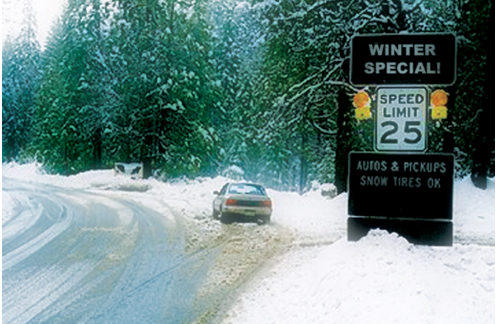I can’t imagine what it’s like to move to Colorado and experience driving in snow for the first time. It’s scary and is much different than driving in normal conditions. Driving on snow and ice is a skill. Use these winter driving tips to keep you and those around you safe during Colorado’s winter.

Make sure your vehicle is Winter Worthy
First, it’s very important to make sure your vehicle is prepared for winter driving. This means up-to-date maintenance, good tires and wiper blades, fluids full, coolant and exhaust system in good shape, gas tank full, and a fully charged battery. Refer here for winter car care to ensure your vehicle is worthy of winter driving.
Driving on Snow and Ice
Go Slow
This is the most basic and fundamental tip for driving in winter. The surest way to avoid an accident or curb check is to go slow–the slower, the better. Seems simple, but this is the main cause for accidents in the snow.
Give extra space between you and the car in front of you
When the ground is slick, stopping becomes an issue. Similar to going slow, allowing extra room in front of you gives you more time to react and brake as it takes longer to bring your vehicle to a complete stop. Remember, you are liable when you hit a car in front of you; make sure to take that option off the table.
Don’t slam on the gas (or brakes)
Slow, deliberate presses to your pedals gets you moving (or stopping) without sliding. Inertia is the key, here. It’s easier to accelerate if you’re moving and easier to stop if you’re slowing down. Seems like common sense, but it’s normal driving habits that get you in trouble come snow and ice.
Make sure your headlights, taillights and windows are clear of snow
Visibility is key, of course. Also, if you forget to clean off snow from your taillights you’re in risk of getting hit from behind.
Don’t stop on a hill
Build up some speed on a flat spot to get up a hill and don’t stop until you’re at the top. There’s not much worse than a car free-sliding down a hill.
Take round-a-bouts VERY slow!
Most of the curb checks we see are from round-a-bouts. Many of these are slightly sloped, so it’s very easy to slide into the curb. Curb checks are a seemingly benign accident however many people are surprised at a $1500 repair bill. Curb checks are oftentimes expensive repairs as they frequently require alignments, control arms, wheels and bearings, tires and struts.
Know your Brakes
If you have anti-lock (ABS) brakes, you do not need to “pump the brakes” and it is normal for the vehicle and brake pedal to pulsate during braking. If you don’t have ABS brakes, make sure you do pump your brake pedal when stopping to prevent a skid. Remember, slamming on your brakes initiates skidding. The key is to stop slowly.
Watch out for ice, including “black ice”
If the road looks shiny and slick, it’s probably icy. Don’t take your chances.
If you do skid…
Look and steer where you want to go. Keep the wheel straight if you want to go straight. Steer into turns. Without slamming the brakes, release the brake pedal and allow your vehicle to come to a stop. Know how to correct both a front tire and rear tire skid. Don’t freak out.
Again, GO SLOW!
Accelerate slow, decelerate slow, drive slow and leave plenty of room in front of you. This is the ultimate winter driving tip. Check out more great advice from AAA, including preparing your vehicle in case of emergencies such as being stuck in the snow for a period of time.